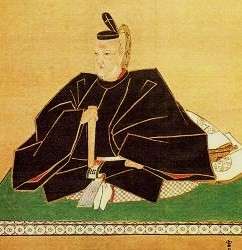Hoshina Masayuki
| Hoshina Masayuki | |
|---|---|
 | |
| Lord of Aizu | |
|
In office 1643–1669 | |
| Preceded by | None |
| Succeeded by | Hoshina Masatsune |
| Personal details | |
| Born |
June 17, 1611 Edo, Japan |
| Died | February 4, 1673 (aged 61) |
| Nationality | Japanese |
| Relations | Father: Tokugawa Hidetada |
Hoshina Masayuki (保科 正之, June 17, 1611 – February 4, 1673) was a Japanese daimyo of the early Edo period, who was the founder of what became the Matsudaira house of Aizu. He was an important figure in the politics and philosophy of the early Tokugawa shogunate.
Biography
Hoshina Masayuki was born in Edo, the illegitimate son of the 2nd shogun, Tokugawa Hidetada. As Masayuki's mother,oshizu was a servant, Hidetada chose to hide the newborn, then named Yukimatsu. This was to protect him from potential infanticide at the hands of Oeyo, Hidetada's wife. Yukimatsu was later secretly given in adoption to Hoshina Masamitsu, a former Takeda retainer, and lord of the Takatō Domain. In 1631, Yukimatsu inherited the Hoshina family headship, as well as the Takatō fief, and changed his name to Masayuki. Later recognized by his father and by his brother, the third shogun Iemitsu, he was able to wield great influence in political affairs, and was to consequently see his income rating rise sharply. Masayuki became lord of the Yamagata Domain and was then moved to the Aizu domain (Mutsu Province, 230,000 koku), and founded the Aizu-Hoshina line (known from his son's generation onward as the Aizu-Matsudaira) which was to remain enfeoffed there until the Boshin War.
Masayuki received great political clout with his rise in income, appointment as one of the shogun's advisors, and regent during the minority of his nephew, the 4th shogun Tokugawa Ietsuna. However, when offered the use of the Tokugawa crest, and the Matsudaira surname, he declined, out of respect to the Hoshina family and its retainers. The crest and surname were adopted during the lordship of his son Masakata.
Masayuki was also a patron of Yamazaki Ansai, one of the early figures in Edo-era Japanese Neo-Confucianism, and together with him wrote the famous Aizu House Code, which included a direct injunction regarding the loyalty of the clan to the Shogun.
Having taken most of the steps toward self-deification, Masayuki was enshrined after his death as the kami Hanitsu-reishin (土津霊神), at the Hanitsu Shrine near Lake Inawashiro.
Anecdotes
Tokugawa Iemitsu asked the famed swordsman Miyamoto Musashi to paint a screen portraying wild ducks. This was to pass into the hands of Masayuki, who took it with him to Aizu, and kept it as one of his family treasures.
References
- Noguchi, Shin'ichi (2005). Aizu-han. Tokyo: Gendai shokan.
- Ooms, Herman (1975). Charismatic Bureaucrat: A Political Biography of Matsudaira Sadanobu, 1758–1829. Chicago: University of Chicago Press.
- Tokitsu, Kenji (2004). Miyamoto Musashi – Life and Writings. Boston: Shambhala.
Further Reading
- Kasuga, Tarō (1985). Hoshina Masayuki-kō: Edo bakusei no genrō: Aizu Wakamatsu-han no oya. Tokyo: Chōeisha: Hatsubaimoto Seiunsha.
External links
- (Japanese) Page featuring the Hanitsu Shrine
- (Japanese) Family background on the Hoshina clan
| Preceded by Hoshina Masamitsu |
Hoshina family head 1631–1669 |
Succeeded by Hoshina Masatsune |
| Preceded by Hoshina Masamitsu |
Daimyo of Takatō 1631–1636 |
Succeeded by Torii Tadaharu |
| Preceded by Torii Tadatsune |
Daimyo of Yamagata 1636–1643 |
Succeeded by Matsudaira Naomoto |
| Preceded by Katō Akinari |
Daimyo of Aizu 1643–1669 |
Succeeded by Hoshina Masatsune |